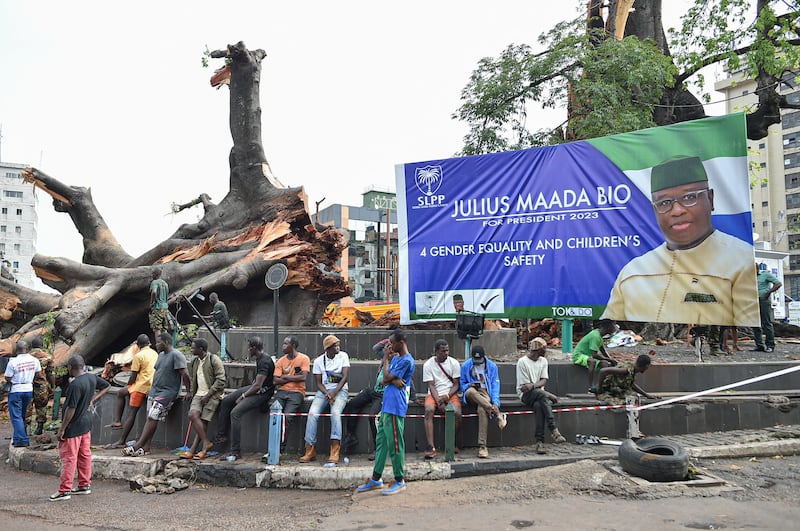In the days after the felling of the huge cotton tree, the symbol of capital city Freetown, Sierra Leoneans gathered to stand by the remaining stump, express their shock, and pay their respects.
The tree, which was hundreds of years old, measured about around 15m wide and 70m tall, until it was destroyed during a storm on Wednesday.
It is said to be where early settlers, who arrived there after they were freed from slavery in North America, prayed and gave thanks.
In the past, Freetown’s cotton tree has been lit up in green on St Patrick’s Day, along with other landmarks around the world.
Desperate search for the 100,000 missing continues as life returns to the streets of Damascus
Intense lobbying for backroom EU jobs plays out below high politics
Crowds throng Syria’s ‘human slaughterhouse’ drawn by hopes of a miracle reunion
A van and a plan: House and furniture hunting in London is not for the faint of heart
Sierra Leonean president Julius Maada Bio visited the site of the tree on Thursday, in the midst of campaigning for next month’s elections.
Afterwards, he tweeted saying that some of the tree’s remains will be taken to Sierra Leonean’s national museum and preserved “as a reminder of our shared heritage and history.”
“The tree was a symbol of freedom and at the heart of the city’s foundation story,” said Vickie Remoe, a Sierra Leonean TV host, writer and entrepreneur, who called the loss “heartbreaking”.
“It was a place to gather, it was a place to meet up.”
As a child, she passed the cotton tree every day after school. “What was great about getting to the tree is I knew I was almost there. There would be all of these bats,” she said. “There are all these stories we used to tell about the bats that lived there and how if they pooped on you it’s like ice cream, all kind of stuff.”

John Wearing, a British Freetown resident, who was on the site of the cotton tree the night it fell, said people are “shocked and sad, but showing typical Sierra Leonean resilience. They are saying that everything has its time and this makes way for something new.”
Isatu Jalloh, a 48-year-old trader, said she has many good memories of resting in the shade of the tree when she was taking breaks from work. “I’m going to miss this tree. My daily life has always been around this tree ... The government needs to plant another tree here, especially for the shade,” she said.
Adama Mabinty Kamara, a 34-year-old who begged and slept near the tree, said she is upset it is gone.
“My friends with disabilities are not happy because here has been our central place because of the shade. This place is close to where prominent people pass by to go to the court, banks and even the State House.”
She wants the government to plant a new cotton tree as soon as possible. “I have a good memory of this place because it is my working place where I beg people to survive ... I think I [now] need to move to the next street to sleep at night.”
Joseph Kaifala, the head of Sierra Leone’s Centre for Memory and Reparations, called the cotton tree “the only constant in Freetown, even when the city was burned down multiple times ... Through all the tragedies Freetown has endured, the cotton tree reminded us that the city was still there. It was a tree of liberty that we must never allow to die.”
He said he would like to see “serious thought” put into any replacement.
“Anything that replaces it must be a symbol of the hope it offered to those who found shelter in Freetown ... It must represent Freetown as a melting pot of cultures, a city of freedom, peace, and hope where all are welcome.”
But not everyone will miss the landmark.
“I’m happy,” said Mohamed Kamara, a 27-year-old who works in a service station and who would like to see flowers planted in the tree’s place. “This tree holds so many evil things, and also [it’s been] stopping the country from moving forward, so I have been wanting this to happen ... Now I believe Sierra Leone is going to move forward.”





